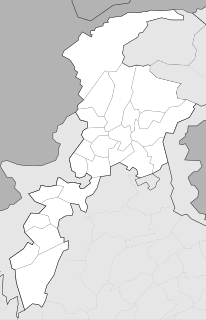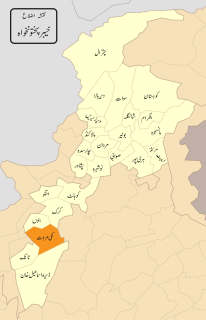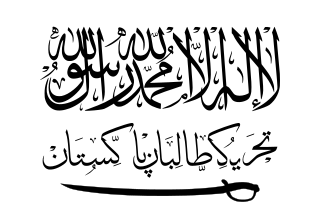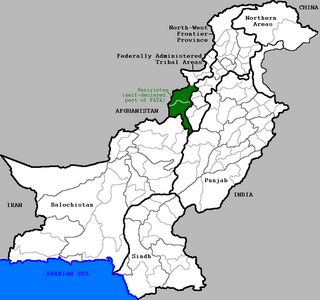
Waziristan is a mountainous region covering the former FATA agencies of North Waziristan and South Waziristan and now districts of Khyber Pakhtunkhwa province of Pakistan. Waziristan covers some 11,585 square kilometres (4,500 sq mi). The area is mostly populated by ethnic Pashtuns. It is named after the Wazir tribe. The language spoken in the valley is Pashto, predominantly the Waziristani dialect. The region forms the southern part of Pakistan's Federally Administered Tribal Areas, which is now part of Khyber Pakhtunkhwa province.

Bannu District is a district of the Khyber Pakhtunkhwa province of Pakistan. It was recorded as a district in 1861 during the British Raj. It is one of 26 districts that make up the Khyber Pakhtunkhwa province of Pakistan. It borders North Waziristan to the northwest, Karak to the northeast, Lakki Marwat to the southeast, and South Waziristan to the southwest. It is represented in the provincial assembly by four MPAs. The district's main city is Bannu.
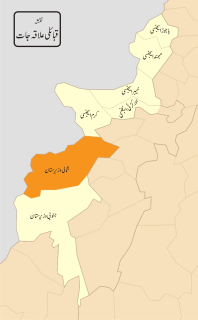
North Waziristan is a former agency of defunct Federally Administered Tribal Area and district of Khyber Pakhtunkhwa province of Pakistan. It is the northern part of Waziristan, a mountainous region of northwest Pakistan, bordering Afghanistan and covering 4,707 square kilometres (1,817 sq mi).

Khyber is a district of Khyber Pakhtunkhwa, Pakistan. Until 2018, it was an agency of Federally Administered Tribal Areas, with merger of FATA with Khyber Pakhtunkhwa, it became a district. It ranges from the Tirah valley down to Peshawar. It borders Nangarhar Province to the west, Orakzai District to the south, Kurram District to south west, Peshawar to the east and Mohmand District in north.
Ghazni Khel is a town and union council of Lakki Marwat District in Khyber Pakhtunkhwa province of Pakistan. It is located at 32°33'30N 70°44'22E and has an altitude of 287 metres. It is located 30 km south to Serai Naurang.
Takhti Khel is a town and union council of Lakki Marwat District in Khyber Pakhtunkhwa province of Pakistan. It is located at 32°48'18N 70°39'12E and has an altitude of 292 metres.
Darkha Sulman Khel is a town and union council of Lakki Marwat District in the Khyber-Pakhtunkhwa province of Pakistan.
Ghandi Khan Khel is a town and union council of Lakki Marwat District in Khyber Pakhtunkhwa province of Pakistan. It is situated between Gambila and Serai Naurang, a tehsil of Lakki Marwat.
Shakh Quli Khel is a Village and union council of Lakki Marwat District in Khyber Pakhtunkhwa province of Pakistan.
Giloti is a town and union council in the Dera Ismail Khan District of Khyber-Pakhtunkhwa. It is located at 32°9'53N 70°45'2E and has an altitude of 180 metres.
Hafiz Gul Bahadur is the leader of a Pakistani Taliban faction based in North Waziristan. Upon the formation of the Tehrik-i-Taliban Pakistan (TTP) in December 2007, he was announced as the militant group's overall naib amir under Baitullah Mehsud, who was based in South Waziristan, but has largely distanced himself from the TTP due to rivalries with Mehsud and disagreements about the TTP's attacks against the Pakistani state.
The 2010 Lakki Marwat suicide bombing occurred on 1 January 2010, in the village of Shah Hassan Khel, Lakki Marwat District, in the Khyber-Pakhtunkhwa province of Pakistan. At least 105 people died and over 100 were injured, many of them critically, when the suicide bomber blew up his sport utility vehicle filled with explosives in the middle of a crowd that had gathered to watch a volleyball game.
Jamaat-ul-Ahrar is a terrorist organization that split away from Tehrik-i-Taliban Pakistan in August 2014. The group came to prominence after it claimed responsibility for the 2014 Wagah border suicide attack. In October 2017, there were unconfirmed reports that Omar Khalid, the leader of the JuA, had died from injuries sustained in a US drone strike in Paktia Province, Afghanistan.
Khyber was the code-name for a military offensive conducted by Pakistan's military in the Khyber Agency in four phases; Khyber-1, Khyber-2, Khyber-3 and Khyber-4.
